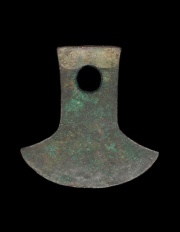Arsenic
Description
A grayish-white nonmetallic element. Arsenic occurs naturally in its elemental form as well as in the minerals arsenopyrite, Realgar, and Orpiment. The abundance of arsenic in the earth's crust is 1.8 ppm. It is found as a trace mineral in meteorites. Arsenic was known as a poison in antiquity and the elemental form was isolated as early as 1250 CE by Albertus Magnus, a German alchemist. Elemental arsenic has three allotropic forms: alpha (gray), beta (black) and an unstable yellow form. When heated, arsenic forms Arsenic trioxide, a white, poisonous gas. Arsenic and its salts are used as wood preservatives, fungicides, herbicides, and pesticides. Arsenic is used as a scavenger in the manufacture of Glass to eliminate any green color resulting from Iron impurities. Arsenic was also used as a Copper alloy predating the use of tin bronzes (Scott, 1991). The arsenic content in ancient and modern coppers alloys ranges from 1 - 8%.
Synonyms and Related Terms
As; grey arsenic; Arseen (Ned.); Arsen (Deut.); arsenikon (Gr.); arsenico (It.); arsênic (Port.); arsénico (Esp.); arsenik (Sven.)
Other Properties
Flame color is light blue; produces a white poisonous smoke that smells like garlic.
Insoluble in water and alkalis. Attacked by oxidizing acids.
Elemental arsenic has a white streak, metallic luster and uneven fracture.
| Composition | As (atomic no. 33) |
|---|---|
| CAS | 7440-38-2 |
| Mohs Hardness | 3.5 |
| Melting Point | 818 (under pressure) |
| Density | 5.778 |
| Molecular Weight | atomic wt = 74.9216 |
| Boiling Point | 615 (sublimes) |
Hazards and Safety
Highly toxic by ingestion and inhalation. Carcinogen and mutagen.
Salts are highly toxic.
International Chemical Safety Card
Additional Information
° D.Scott, Metallography and Microstructure of Ancient and Historic Metals, Getty Conservation Institute, 1991.
° L. Goldberg, A History Of Pest Control Measures In The Anthropology Collections, National Museum Of Natural History, Smithsonian Institution, JAIC (35):23-43, 1996
° Mineralogy Database: Arsenic
° Web Elements: Website
Sources Checked for Data in Record
- G.S.Brady, Materials Handbook, McGraw-Hill Book Co., New York, 1971 Comment: p.
- Richard S. Lewis, Hawley's Condensed Chemical Dictionary, Van Nostrand Reinhold, New York, 10th ed., 1993
- Van Nostrand's Scientific Encyclopedia, Douglas M. Considine (ed.), Van Nostrand Reinhold, New York, 1976
- Random House, Webster's Encyclopedic Unabridged Dictionary of the English Language, Grammercy Book, New York, 1997
- The Merck Index, Martha Windholz (ed.), Merck Research Labs, Rahway NJ, 10th edition, 1983 Comment: entry 832
- Encyclopedia Britannica, http://www.britannica.com Comment: "arsenic" Encyclopædia Britannica [Accessed December 11, 2001 (color photo)
- Chemical & Engineering News, American Chemical Society, Washington DC, 81 (36) , Sept. 8, 2003
- C.W.Chesterman, K.E.Lowe, Audubon Society Field Guide to North American Rocks and Minerals, Alfred A. Knopf, New York, 1979
- David C. Scott, Metallography and Microstructure of Ancient and Historic Metals, The Getty Conservation Institute, Los Angeles, 1991
- Art and Architecture Thesaurus Online, http://www.getty.edu/research/tools/vocabulary/aat/, J. Paul Getty Trust, Los Angeles, 2000
